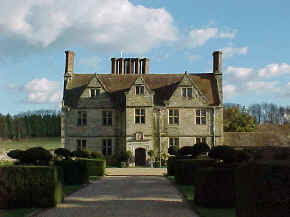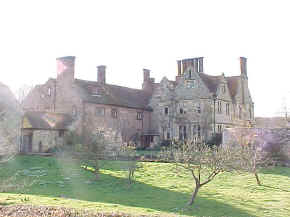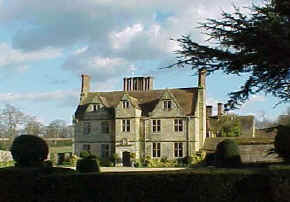The Culpepers of Great Wigsell
Salehurst, East Sussex
 Great
Wigsell Great
Wigsell
Owned for three centuries by direct ancestors of the
modern-day Culpeppers
The area where Great Wigsell sits today
is about eight miles
south of Goudhurst, lying close under the southwestern border of Kent, not far
from
Bayhall and Bedgebury. The land was purchased in 1348 by Sir John Culpeper5 of
Bayhall who was the sheriff of the county Kent starting in 1370.
For its first century and a half of
Culpeper ownership, Wigsell consisted of some 600 acres of plough and
pasture, with even more land of wood and heath, in the Sussex parish
of Salehurst. Fairfax Harrison says, "It was not yet a
place of residence, however: its original value lay in the supply of
charcoal which its forest cover provided for the iron smelting
industry in which the Culpepers, like so many of their neighbors in
the Weald, were profitably engaged in the fourteenth and fifteenth
centuries."
Upon the first marriage of Sir Thomas
Culpeper6 of Bayhall, Wigsell was given to him by his
father, Sir John5.
From Sir Thomas6, the land
passed to his son, Walter Culpeper7 who fought at
Agincourt. In about 1425, Walter married the widow of the last
Bedgebury of Bedgebury in Goudhurst and
was buried with that family in Goudhurst
church, as was his son Sir John8, who inherited
Hardreshull, Bedgebury and Wigsell from his father.
 Sir John8 was knighted by
Edward IV in 1468 and made sheriff of county Kent. He left a will
disposing of his estates among two sons, Alexander9 and
Walter9. These estates included the manors acquired by the
Bedgebury marriage (Bedgebury and Haselden) in Kent, an inherited
Culpeper manor (Wigsell) in Sussex, and certain lands in Essex which
Sir John had purchased. Despite the Kentish custom of gavelkind, the
elder son, Alexander9, was only given the lands in Kent,
and the younger, Walter9 received those in Sussex and
Essex. Sir John8 was knighted by
Edward IV in 1468 and made sheriff of county Kent. He left a will
disposing of his estates among two sons, Alexander9 and
Walter9. These estates included the manors acquired by the
Bedgebury marriage (Bedgebury and Haselden) in Kent, an inherited
Culpeper manor (Wigsell) in Sussex, and certain lands in Essex which
Sir John had purchased. Despite the Kentish custom of gavelkind, the
elder son, Alexander9, was only given the lands in Kent,
and the younger, Walter9 received those in Sussex and
Essex.
Harrison says, "At the death of
Sir John,8 Wigsell must already have been somewhat denuded
and so of less value than it had been; but the title was sufficient,
nevertheless, to enable its inheritor (Walter9) to pursue
the thrifty practice of his ancestors and negotiate a marriage which
established Culpeper of Wigsell for a century and a half to come... He
married in 1500(?) Anne, daughter and heiress of Harry Aucher of Lossenham.
in Newenden, co. Kent."
Walter9, began life, like
his grandfather, the squire of Agincourt for whom he was named, as a
professional soldier; but, unlike his grandfather, he did not live to
retire to his estates. In 1508 he was reported as the under marshal of
Calais. Three years later, in November, 1511, being then recited a
'squire of the body' of Henry VIII, he was granted also the post of
bailiff of the Scavage of Calais and the isle of Colne. His crowding
hour came in August, 1513, when his young King was engaged in the
invasion of France to assert an outworn claim of inheritance of that
realm, and it was Walter's fortune to be left for the moment in
responsible command of the garrison of Calais. In the face of a
surprise attack in which the French greatly outnumbered the English
and Walter's heir, William Culpeper10
appears to have begun life as a practicing lawyer.
 In 1538 he was
included in the long list of gentlemen enrolled as aids to Thomas
Cromwell the powerful Vicar General and Lord Privy Seal to Henry VIII.
At this time, he lived at Hunton, which was not owned by the
Culpepers. At the very end of his life, William settled down at
Wigsell, and his heir at his death in 1559 was his son John11. In 1538 he was
included in the long list of gentlemen enrolled as aids to Thomas
Cromwell the powerful Vicar General and Lord Privy Seal to Henry VIII.
At this time, he lived at Hunton, which was not owned by the
Culpepers. At the very end of his life, William settled down at
Wigsell, and his heir at his death in 1559 was his son John11.
Little is known of John Culpeper11
of Wigsell other than he was a justice of the peace and lived a long,
uneventful life at Wigsell, John held Wigsell for 53 years, and at his
death in 1612, passed it to his son, Thomas12.
Thomas Culpeper12
inaugurated his family's interest in Virginia, but held Wigsell for
only one year before his death in 1613. His heir was his son John
Culpeper13
who was to become Lord Culpeper, first Baron of Thoresway.
In 1623, John Culpeper13
sold Wigsell to his cousin, Thomas Culpeper12 of
Hollingbourne who then gave Wigsell to his son, Sir Cheney Culpeper13.
After having been a Culpeper possession
for 300 years, Wigsell passed, in the ruin of Sir Cheney Culpeper's
estate, in 1625 to Richard English
who had been 'table boy under the Colepepers whom at length he bought
out.' Upon its sale, the original foundation was used to build the
magnificent manor house that stands today and is called Great Wigsell. Ultimately,
it came to a branch of the Harcourt family and in the 1920'a was the
residence of Lord Edward Cecil of the Egyptian service. The house has
been several times rebuilt and so now bears little relation to its
appearance when the Culpepers possessed it.
Photographs by Warren Culpepper, March
2000.
Location: On the west side of the
B2244, just across the Kent/East Sussex border, about 1.5 miles S of
St. Laurence Church, Hawkhurst. (8 miles SSE of Goudhurst.)
National Grid Coordinates:
TQ 761 274

A Visit to Great Wigsell
In October, 1999, Culpepper Connections'
publisher Warren Culpepper and his wife Lee, had the opportunity to
visit Great Wigsell and its current owner. This came about from an
inquiry we made at the public house across the street from Salehurst
Church.
We inquired to those in the pub if anyone knew the
location and/or the owner of Great Wigsell. One couple said that they
had attended a charity fund-raiser there and had met the current owner,
an American woman. The couple gave us her name and we phoned to see if
it might be possible to visit the house.
At the time, we had no idea of its scale or grandeur.
While the owner didn't return the call for several days, she eventually
did call, explaining she had been away in London. When I told her my
interest in and connection to the house, she graciously invited us over
for drinks the next evening.
The visit was delightful and the owner kindly showed
us the mansion from top to bottom. The complete tour must have taken
over an hour.
While the current home reportedly bears little
resemblance to the home of the Culpepers of the 15th, 16th and 17th
centuries, it is a most impressive home today, just as it apparently was
several centuries ago.

Wigsell Culpeper Dates, Ownership (Monarch)
Until the later half of the 15th century, Wigsell was
farmland and woods, not a place of residence:
 |
?-1348: Simon de Etchingham |
 |
1348-1370: Sir John Culpeper5 of
Bayhall and Hardreshull
(Edward III) |
 |
1370-1428: Sir Thomas Culpeper6
of Bayhall, Hardreshull and Exton
(Edward III, Richard III, Henry IV-VI) |
 |
1428-1462: Walter Culpeper7 of
Goudhurst
(Henry VI, Edward IV) |
 |
1462-1480: Sir John Culpeper8 of
Goudhurst
(Henry VI, Edward IV) |
Sometime during the tenure of Sir John8, Wigsell was
developed as a residence:
 |
1480-1516: Walter Culpeper9 of
Wigsell and Under Marshall of Calais
(Edward IV-V, Richard III, Henry VII-VIII) |
 |
1516-1532: Ann Culpeper9, dowager of Walter
(Henry VIII) |
 |
1532-1559: William Culpeper10, Esq.
(Henry VIII, Edward VI, Mary, and Elizabeth) |
 |
1559-1612: John Culpeper11
of Wigsell, Esq.
(Elizabeth, James I) |
 |
1612-1613: Thomas Culpeper12 of Wigsell
(James I) |
 |
1613-1623: John Culpeper13of
Wigsell,
later Lord Culpeper, First Baron of Thoresway
(James I) |
 |
1623-1625: Sir Cheney Culpeper13
(Wigsell was bought for Cheney by his father Sir Thomas12
of Hollingbourne from his cousin John13)
(James I) |
 |
1625-?: Richard English

|
Saint Mary the Virgin Church, Salehurst
|
Last Revised:
02 Jan 2015
|
|